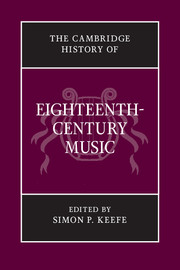Book contents
- Frontmatter
- PRELUDE
- PART I MUSIC FOR THE CHURCH
- INTERLUDE
- PART II MUSIC FOR THE THEATRE
- 8 Italian opera in the eighteenth century
- 9 Opera in Paris from Campra to Rameau
- 10 An instinct for parody and a spirit for revolution: Parisian opera, 1752–1800
- 11 German opera from Reinhard Keiser to Peter Winter
- 12 The lure of aria, procession and spectacle: opera in eighteenth-century London
- 13 Music theatre in Spain
- 14 Opera in Sweden
- INTERLUDE
- PART III MUSIC FOR THE SALON AND CONCERT ROOM
- POSTLUDE
- Appendix I Chronology
- Appendix II Institutions in major European cities
- Appendix III Personalia
- Index
- References
8 - Italian opera in the eighteenth century
from PART II - MUSIC FOR THE THEATRE
Published online by Cambridge University Press: 28 March 2011
- Frontmatter
- PRELUDE
- PART I MUSIC FOR THE CHURCH
- INTERLUDE
- PART II MUSIC FOR THE THEATRE
- 8 Italian opera in the eighteenth century
- 9 Opera in Paris from Campra to Rameau
- 10 An instinct for parody and a spirit for revolution: Parisian opera, 1752–1800
- 11 German opera from Reinhard Keiser to Peter Winter
- 12 The lure of aria, procession and spectacle: opera in eighteenth-century London
- 13 Music theatre in Spain
- 14 Opera in Sweden
- INTERLUDE
- PART III MUSIC FOR THE SALON AND CONCERT ROOM
- POSTLUDE
- Appendix I Chronology
- Appendix II Institutions in major European cities
- Appendix III Personalia
- Index
- References
Summary
The history of Italian opera in the eighteenth century is as much the history of theatres, cities and performers as it is the history of composers, genres and works. Its study has benefited from a number of masterful recent inquiries that take a variety of approaches. The present summary views the history of Italian opera in the eighteenth century through the lens of the opera theatre, focusing on genres and their venues, seeking to elucidate categories of opera theatres – within and extending outside of Italy, in places where Italian opera was favoured – and exploring the implications of these varieties for the style of repertory represented by them. By no means a comprehensive overview of the history of all eighteenth-century theatres, nor a survey organized strictly according to cultural centres, composers, genres, or works (although these play integral roles), it highlights specific theatres and works, placing them in the context of the production process. Composers of eighteenth-century opera sought to ‘tailor’ their arias to an individual singer like a suit of clothes. Applied more broadly, this famous metaphor might be expanded to entire operatic works themselves, allowing us to explain them as whole, integrated entities – they are manifestations of the preferences, status, conditions, background and identities of the patrons and audiences for whom they were produced and the facilities for which they were designed.
- Type
- Chapter
- Information
- The Cambridge History of Eighteenth-Century Music , pp. 201 - 271Publisher: Cambridge University PressPrint publication year: 2009

